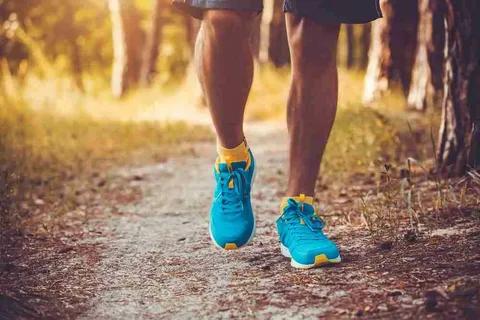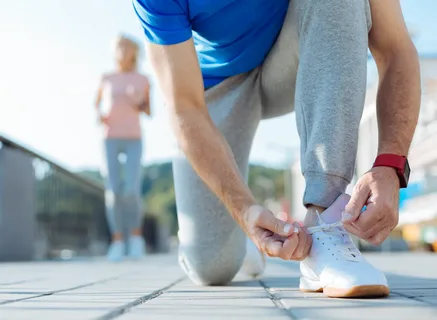If you’re feeling the pain of plantar fasciitis, you know how difficult it can be to find the best walking shoes for plantar fasciitis. But you don’t have to go through this alone! We’ve gathered our favorite walking shoes to help relieve your symptoms while providing all-day comfort. In this guide, we’ll cover everything from shoe types and brands to aftermarket insoles and other accessories so that no matter what kind of shoe you need, we’ve got your back.
What is Plantar Fasciitis?
Plantar fasciitis is the inflammation of the plantar fascia, a thick band of connective tissue that runs from your heel to your toes. The plantar fascia supports your arch by absorbing shock and distributing pressure throughout your feet as you walk, run, or jump. When you’re standing, this band creates an arch between all five toes (as well as two other small arches).
When you walk, these arches flatten out slightly because they’re stretched across your foot–but when someone has plantar fasciitis, the strain on this ligament causes it to become inflamed in response to overuse or injury. Plantar fasciitis pain usually occurs at night when lying flat on one’s back; this position puts extra stress on the plantar fascia due to gravity pulling down on it while asleep!
The Best Shoes for Plantar Fasciitis
Supportive shoes are best. The best shoes for plantar fasciitis are supportive walking shoes with a cushioned sole and arch support. If you have plantar fasciitis, wear shoes that adequately support the foot and arch. In addition, you should avoid wearing high heels or flip-flops because they put more pressure on your heel when standing up. Wear supportive shoes with arch support if you have flat feet. You can also use insoles to help improve the condition of your feet and relieve pain caused by plantar fasciitis.
Plantar fasciitis is a common condition that can be treated with lifestyle changes, such as wearing supportive shoes and insoles. If you have severe pain in your heel or arch, talk to your doctor about the best treatment options for you. If you have plantar fasciitis, wearing supportive shoes with arch support is essential. You can also use insoles to help improve the condition of your feet and relieve pain caused by plantar fasciitis.
How to Choose the Best Shoes for Plantar Fasciitis?
If you’re suffering from plantar fasciitis, there are certain features that shoes should have to help relieve your pain.
- A wide toe box is essential because it allows the toes to spread out and prevents them from being cramped together. This makes walking more comfortable and helps reduce stress on the plantar fascia ligament.
- A heel counter will keep the foot in place during activity, which reduces movement at the back of your foot, where pain often occurs due to inflammation or irritation of surrounding tissues such as nerves and tendons.
- Padded collars around ankles provide comfort by absorbing shock when walking on hard surfaces such as concrete or asphalt; this helps reduce strain on joints throughout the legs (knees), hips, lower back, etc.
- Cushioning soles provide extra protection against impact when walking over uneven terrain like cobblestones or gravel paths – these materials are designed specifically for shock absorption purposes, so they won’t compress under pressure like regular cushioning materials do!
They also provide better traction when walking uphill/downhill slopes, which means less slipping than traditional soles might offer (especially if wet)…which leads me to my next point…
Supportive Walking Shoes for Plantar Fasciitis Relief
If you have plantar fasciitis, your best bet is to buy supportive walking shoes for plantar fasciitis with shock-absorbing properties. These shoes are designed to provide extra cushioning and protection for the foot. They’re not necessarily the most expensive option, but they can help reduce the pain and discomfort from wearing high heels or other footwear types that may stress your feet.
There are many different brands out there that make supportive walking shoes for plantar fasciitis relief–the key is finding one that fits well and feels comfortable while still providing adequate support for your feet! If you have plantar fasciitis, it can be tempting to try and find shoes that provide extra cushioning and shock absorption. This isn’t always the best idea–if your shoes are too soft and need to offer more support for your feet, they may worsen things.
We are Emphasizing the Need for Supportive Footwear for Relief.
As you can see, many different types of shoes can help alleviate the pain caused by plantar fasciitis. The key is choosing a shoe that is both supportive and cushioned. A supportive shoe will support your foot as it moves through its natural range of motion, reducing pressure on the arches and heel. Cushioned soles provide additional shock absorption for comfort and stability while walking or running on hard surfaces like concrete or asphalt.
The best way to find the right shoe for plantar fasciitis is by trying different types of shoes and seeing how they feel. You may need multiple pairs before you find one that fits well, but it’s worth the effort. When you find a pair of shoes that feels good, wear them for at least a week before deciding whether or not they are the right ones. You want to give yourself time to adjust to the new footwear before making final decisions.
The Role of Cushioned Soles in Reducing Pressure on the Feet.
Cushioned soles are a great way to reduce pressure on the feet, especially with plantar fasciitis. The more cushioning in your shoe, the better it will absorb shock and reduce stress on your foot. The ideal sole thickness should be enough to absorb shock but not so thick that it interferes with walking or running movements. The right amount of cushioning can help prevent plantar fasciitis by dispersing force across your whole foot instead of concentrating it on just one part. The most important thing is to find a shoe that fits well and feels comfortable.
Do you need a plantar fasciitis shoe? It’s up to you. There are plenty of options, so if your shoes aren’t working, try something new! If you have plantar fasciitis, you’re looking for ways to make it go away. Unfortunately, there is no cure for PF. The best thing you can do is take good care of your feet and learn how to manage the pain. If you have any questions or concerns about this information, please talk with your doctor.
If you have plantar fasciitis, there’s a good chance you’re looking for ways to make it go away. Unfortunately, there is no cure for PF. The best thing you can do is take good care of your feet and learn how to manage the pain. If you have any questions or concerns about this information, please talk with your doctor.
Common Misconceptions About Plantar Fasciitis Footwear.
It’s not just about arch support. Many people think the key to finding a good pair of shoes is looking for one with high arch support, but this isn’t always true. Some people have low arches, so they need extra cushioning in the heel instead of extra padding under their feet.
It’s not just about heel height. One common misconception is that all plantar fasciitis shoes are designed with high heels because they’re supposed to help reduce stress on your Achilles tendon and stretch out your calf muscles when you walk in them–but this isn’t always true either! Some experts recommend wearing flat-soled shoes if your symptoms are severe enough that they can’t be treated with other methods like stretching exercises or icing your foot after workouts (which we’ll talk more about later).
If after trying both types of footwear options and neither seems right for you, then consider trying another kind altogether, like minimalist sneakers, which offer less cushioning but tend not to require any breaking-in period either since there aren’t any seams inside
How Shoes With Shock-Absorbing Properties Protect The Feet.
Shock-absorbing soles help reduce the impact of walking on the feet. The material used in these shoes can be hard or soft foam, which comes in many different forms. EVA (ethylene vinyl acetate) is one type of soft foam that’s commonly found in shock-absorbing shoes, but TPU (thermoplastic polyurethane) and PU (polyurethane) are other common types of shock-absorbing soles as well.
EVA soles are typically made of polystyrene beads placed in a mold and then heated to form the final shape. TPU and PU, on the other hand, are usually made by mixing polymers and heating them until they become liquid. These materials are then poured into a mold and allowed to cool. Once they’ve cured, you get a complex piece of shock-absorbing material ready to be cut into whatever shape is needed.
FAQs
Q: What are plantar fasciitis shoes?
Ans: Plantar fasciitis shoes are specially designed footwear that provides ample arch support and cushioning to alleviate pain and discomfort associated with plantar fasciitis.
Q: How do plantar fasciitis shoes help?
Ans: These shoes offer superior arch support, proper heel cushioning, and a supportive sole, which helps to distribute pressure evenly and reduce strain on the plantar fascia, easing the pain of plantar fasciitis.
Q: Are plantar fasciitis shoes effective?
Ans: Yes, they can be highly effective in managing plantar fasciitis symptoms. The proper design and support they provide can alleviate pain and improve comfort during daily activities.
Q: Can I wear plantar fasciitis shoes every day?
Ans: Yes, you can wear them daily. In fact, using these shoes consistently can help in providing ongoing relief and may aid in preventing plantar fasciitis flare-ups.
Q: Can plantar fasciitis shoes be stylish?
Ans: Yes, there are numerous stylish options available today. You don’t have to compromise on fashion to enjoy the benefits of plantar fasciitis shoes.
Q: How do I choose the right pair of plantar fasciitis shoes?
Ans: Look for shoes with good arch support, a cushioned heel, and a firm sole. Ensure they fit well and provide adequate room for your toes.
Conclusion
We hope this guide has helped you understand the importance of supportive footwear for plantar fasciitis. The best shoes for plantar fasciitis will protect your feet and help you avoid pain and discomfort while walking. If you still need to decide which shoe suits your situation, please contact us with any questions or concerns!
| Other Good Articles to Read |
| Skank Blogs |
| Unreal Blogs |
| Tba Blogs |
| All City Forums |
| Dany Blogs |
| Refuge Blogs |
| The Music Blogs |
| Key Forums |
| The Big Blog Theory |
| Joe Blogs |
| Blogs 4 Me |
| Blogs Emon |



